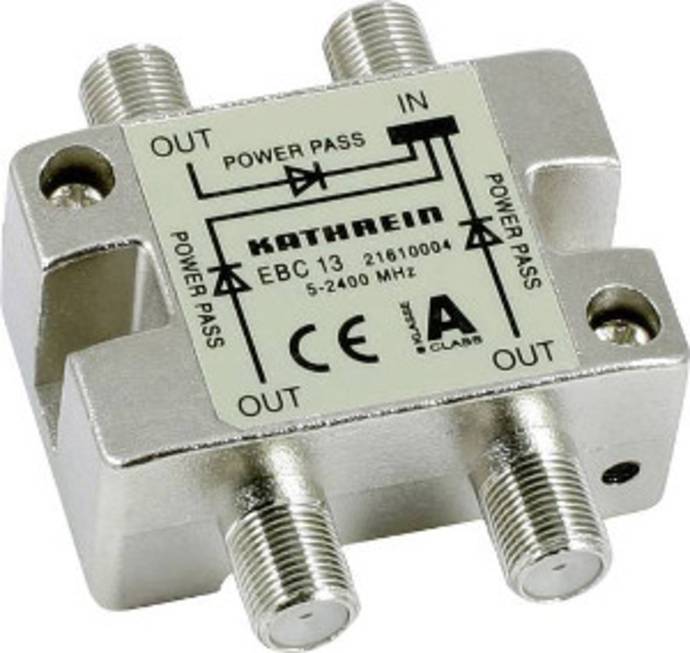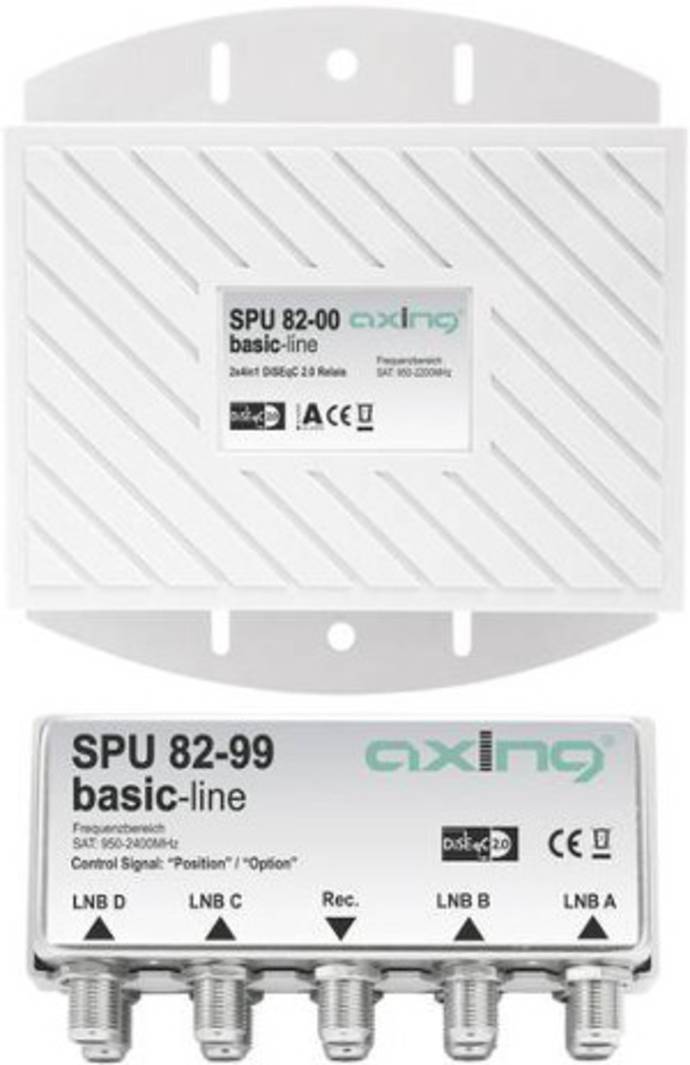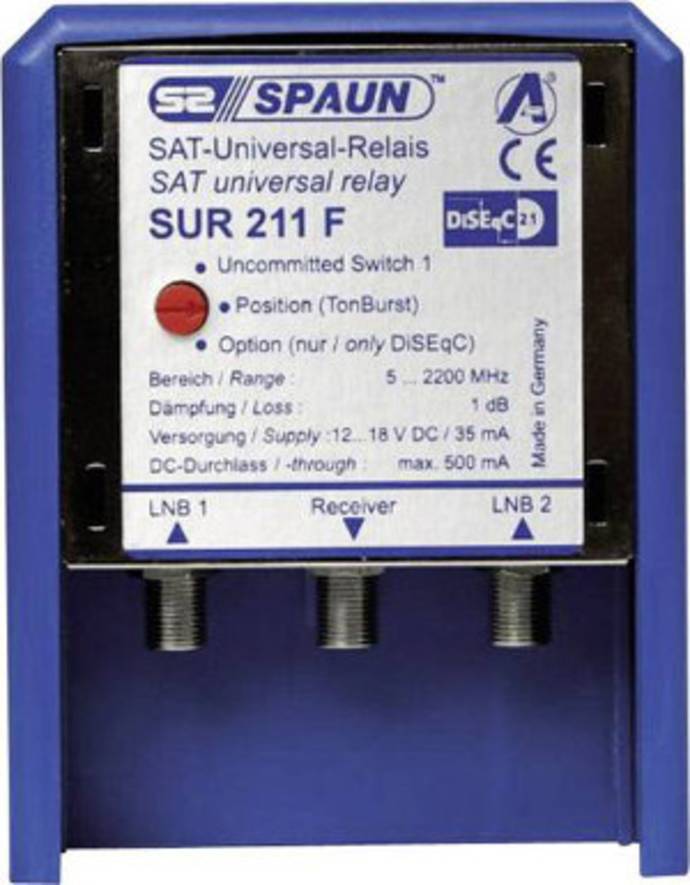All products
Guide
Useful information about SATELLITE distributors & multiswitches
What are SATELLITE distributors and multiswitches?
Which SATELLITE distributors and multiswitches are available from Conrad?
FAQ – frequently asked questions about SATELLITE distributors and multiswitches
What are SATELLITE distributors and multiswitches?

With the possibility of receiving television channels by satellite, an important step has been taken toward the extraordinary diversity of information and entertainment that we now take for granted. Satellites with fixed positions in orbit (so-called geostationary satellites) radiate thousands of television and radio channels on defined frequency bands. By means of a parabolic mirror, the signals are mirrored at the receiving location and focused like in a burning glass. In this focus is the receiver of the signals, the LNB (English for "Low Noise Block"). The signals from satellites are transmitted in different planes, one speaks of polarization. The LNB detects these levels and converts them into processing-capable signals.
The signal from satellites is received at different angles at the receiving location. As a result, a movable parabolic mirror, several of them or several LNBs at a parabolic mirror are required to receive the signals. FOR the use of these possibilities, SATELLITE distributors and multiswitches are used.
All products offered by Conrad are used between the receiver antenna and the signal receiver . They are shielded against the radiation and interference signals and are equipped with earthing possibilities. Some of the products are weatherproof and therefore suitable for outdoor installation.
Which SATELLITE distributors and multiswitches are available from Conrad?
THE SATELLITE distributors and multiswitches ensure the control and distribution of THE SATELLITE signals in satellite reception systems . In particular, the products available in the Conrad online shop are divided into the following categories:

SAT DiSEqC Switches
The abbreviation DiSEqC in DiSEqC switch stands for "Digital Satellite Equipment Control". Thus, control signals are transmitted directly in the high-frequency cable in the cabling of satellite systems. In this way, switching processes between the polarization level, different LNBs or antennas can be triggered. DiSEqC is an open, license-free digital industry standard .
SAT Cable Television Headends
SATELLITE cable head stations with the connected LNBs provide for the reception of satellite signals in all polarization levels and their conversion into forwarding and usable signals to the terminals. The stations are set up by a specialist with special software to meet the needs of the reception area. Manufacturers offer the corresponding open source software for programming the head stations on their Internet pages.
SAT 5-Way Multiswitches
SAT multi-switches process the input signals of LNBs in all polarization levels and distribute the signals to the consumption points. The devices are often equipped with integrated amplifiers and partly allow DiSEqC control of the corresponding LNBs.
SAT Multiswitch Extensions & Cascades
These products are used to increase the number of potential recipients . THESE are OFTEN extensions with integrated amplifiers IN THE CASE OF SATELLITE multi-switches, in order to ensure the necessary signal strength for each connection.
SAT Amplifier
SAT amplifiers are used to maintain the necessary satellite signal level on the way to the receivers. Several amplifiers for the levels of THE SATELLITE signal are used in one housing, partly also for terrestrial signals.
SAT Splitters
These are passive components that only distribute THE SATELLITE signals to a larger number of lines . THE SATELLITE distributors are mostly made of die-cast and are partly surrounded by plastic housings. Inputs and outputs are uniquely labeled. Some distributors are suitable for looping through the power supply via THE SATELLITE cable.
In the Conrad online shop, you can filter the products offered by SATELLITE technology according to other criteria such as price, customer rating, store availability and manufacturer (brands). In addition, there are special selection options that are based on the product or the requirements of THE SATELLITE system.
Good to know:
The installation of satellite systems and the assembly of the components require a high degree of expertise and diligence, as high frequencies and low signal strengths are used. This starts with the correct alignment and reliable attachment of the receiver elements (parabolic mirrors, LNBs). Great care is also required when laying and connecting the cables. Small errors can cause high signal losses, which seriously impair or even make reception impossible. Unused signal inputs and unit outputs must be terminated with specified resistors.
FAQ – frequently asked questions about SATELLITE distributors and multiswitches

What safety instructions must be observed?
- All devices that are connected to the low-voltage power supply must only be installed by electrical specialists.
- Devices connected to the low-voltage power supply may only be installed in dry indoor locations. Installation on or near easily flammable materials is not permitted.
- The devices offered here are only for use in satellite reception systems.
- Use the manufacturer's data sheets for expert information before you start planning A SATELLITE system.
- Ensure free air circulation in devices that are connected to the mains voltage in order to avoid overheating. Observe the permissible ambient temperature according to the accompanying documentation.
- Do not place liquid-filled objects on power supplies. The mains adapter must not be exposed to dripping or splashing water. The mains plug must be easily accessible and usable.
- To prevent damage, attach and loosen all components only with suitable tools.
How do I detect defects in SATELLITE distributors and multiswitches?
The signal remains off, thus no reception is possible. Special measuring devices are required for signal tracking. Causes of problems may include:
- Interrupted power supply due to defective power supplies or fine-wire fuses
- Breaks, kinks or chafing on the HF cables
- Moisture ingress in improperly sealed housings of THE SATELLITE components